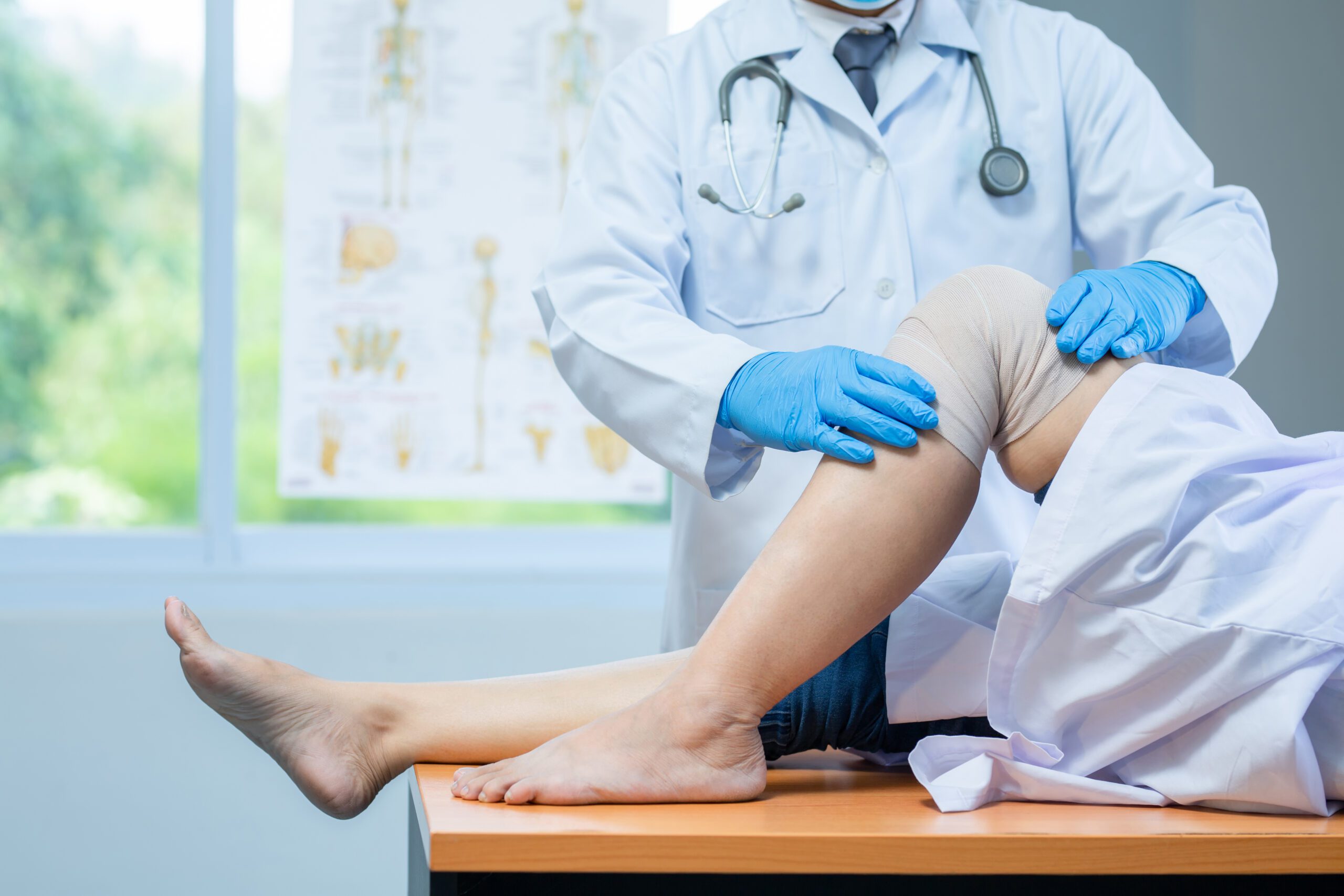Arterial Ulcers
Arterial Ulcers
See how you can benefit from advanced, comprehensive treatment for arterial ulcers at Innovative Wound Care Specialists.
Arterial ulcers develop on the lower leg or foot from insufficient blood flow. These non-healing wounds can appear round or oval in shape and look “punched out.” Arterial ulcers can trigger pain while at rest and while active. Treating arterial ulcers is paramount to prevent infection and additional complications.
Since they can progress rapidly, detecting arterial ulcers early is crucial for timely treatment and further prevention. Patients with existing wounds or ulcers, caregivers, family members, healthcare providers, and people with limited mobility should know the signs of arterial ulcers and when to seek out medical attention.
Start Treatment Today
For those living with diabetes and neuropathy, the risk of developing foot ulcers is a constant concern. Neuropathy can dull sensations in the feet, so minor injuries may go unnoticed and untreated for an extended period of time, often becoming worse. Poor blood circulation further complicates the healing process, as it increases the likelihood of infection and more severe outcomes, including amputation.

Awareness of the signs and symptoms of arterial ulcers is essential to prevent infection, receive proper treatment, and reduce pain.
Here of some key signs and symptoms to look for:
Dry Sore
- Round or oval-shaped sore with dead skin on the ridge
- Red, yellow, or black in appearance
- Skin may look shiny, tight, thin, or dry
- Localized pain
- Reduced pulse in the foot
- Swelling in the leg and ankle
- Numbness or weakness in the leg
Several conditions can cause arterial ulcers, such as:
- Peripheral Arterial Disease: PAD is a condition of plaque build-up in the leg’s arteries, with a restriction of blood flow.
- Diabetes: Since diabetes can cause PAD, it can serve as another causation for the development of arterial ulcers due to narrowing of the arteries and low blood flow.
- Trauma: Direct and sudden force to the body, such as the legs, can damage the arteries, impacting their blood flow, which can cause arterial ulcers.
- Atherosclerosis: Atherosclerosis is a condition where blood flow to the legs is restricted, causing tissue damage and ulcer development.
Factors and conditions that can increase the risk of developing arterial ulcers include:
- Age: Those over 60 have a higher risk of developing arterial ulcers as arteries can become more narrow with age.
- Obesity: An unhealthy amount of weight can also increase the risk of developing arterial ulcers, as obesity can cause hypertension, which leads to a reduction of proper blood flow.
- Previous trauma to the leg: Sudden trauma or force to the leg can cause damage to blood vessels, impacting their blood flow.
- History of heart disease: Heart-related diseases, like atherosclerosis, can cause plaque buildup in the artery walls, leading to narrowed arteries.
- Improper footwear: Those with underlying health conditions like diabetes may be at risk of developing arterial ulcers from wearing inappropriate footwear, as poor footwear can put pressure on the feet and hinder blood circulation.
- Lack of physical activity: A sedentary lifestyle can increase the risk of arterial ulcers in patients with underlying health conditions, as lack of physical activity can decrease proper blood flow.
Proper wound dressings can help heal arterial ulcers, typically occlusive ones. Occlusive dressings create a moist environment for the wound to reduce inflammation and promote optimal healing. Some occlusive dressings that medical providers usually use to treat arterial ulcers include:
- Hydrocolloid Dressings
- Hydrogel Dressings
- Foam Dressings
A medical provider may suggest surgery in severe arterial ulcers to prevent additional complications. Surgical procedures to treat arterial ulcers include:
- Angioplasty: An angioplasty is a minimally invasive surgical procedure to open blocked or narrowed arteries in patients with arterial ulcers. It is performed by inserting a catheter with a balloon on the tip into the blocked or narrow artery. The balloon inflates, which helps to open or widen the affected artery, and may be kept open with the help of a stent.
- Bypass Surgery: Bypass surgery for arterial ulcers is an invasive surgery to encourage blood flow in a blocked or narrow artery by redirecting its flow. This helps restore proper blood flow to help heal arterial ulcers. Bypass surgery for arterial ulcers involves taking a healthy blood vessel as a graft, placed above and below the blocked artery to reroute the blood.
- Skin Grafting: For chronic arterial ulcers, skin grafting can help to bring healing and tissue growth to the ulcer(s) by moving one healthy portion of the skin to cover the ulcer. The skin graft over the ulcers brings healing to the ulcers as the graft creates its blood supply and connects with the nearby tissue.
- Amputation: In severe cases of arterial ulcers, an amputation may be the only option to prevent further complications from this condition. If the affected area has experienced infection, tissue necrosis, or severe restriction of blood flow, then amputation of the affected limb, such as a leg, may be needed.
Medications are additional treatment options for arterial ulcers, as many are focused on addressing the underlying issue of arterial ulcers: lack of blood flow. Here are the most commonly used medications for arterial ulcers:
- Aspirin: With the help of its anti-inflammatory properties, aspirin can help with the symptoms of arterial ulcers by encouraging proper blood flow in the legs, which in turn decreases pain. Aspirin also helps prevent blood blockage and blood clotting, all of which are risks with arterial ulcers.
- Vasodilators: Vasodilators are medications that widen the blood vessels and promote the improvement of blood flow for arterial ulcer patients. Improving blood circulation can also aid in healing and new tissue growth.
- Pentoxifylline: The primary role of medicines like pentoxifylline is to decrease blood clotting in arterial ulcer patients to better help with blood flow through narrow blood vessels, which is essential for overall wound healing.
In addition to medications and wound dressings, lifestyle changes can also help to alleviate symptoms associated with arterial ulcers, including:
- Regular exercise
- Maintaining a healthy weight
- Proper footwear
- Intentional foot care
- Elevate legs
- Limit or quit tobacco use
If you believe you have arterial ulcers, you must immediately contact your medical provider for a full assessment. Key signs and symptoms of arterial ulcers that signal it is time to see a doctor include the following:
- Severe pain in the affected area
- Changes in skin color of the affected area
- Non-healing wound(s)
- Numbness of the affected area
- Hair loss in the affected area
- Lack or decrease of pulse in the affected area
- Worsening of pain at night in the affected area
If these signs are present, your provider will have you undergo the appropriate tests and assessments to determine if you have arterial ulcers or another related condition. They will assess the appearance of your wound and measure blood flow to determine the state of the ulcer and what treatment options are needed.

Patient and wound assessments are essential components of the wound care process, playing a crucial role in understanding the patient’s overall health, identifying factors that may impact wound healing, and tailoring an effective treatment plan.
Assessing the patient’s overall health, medical history, and lifestyle factors helps healthcare professionals at IWC understand potential underlying conditions that may affect wound healing. Factors that may affect wound healing include diabetes, vascular disease, nutritional status, and immune function.
At Innovative Wound Care Specialists, we provide a comprehensive range of advanced treatments to promote effective wound healing and enhance overall well-being. From Compression Dressings to Hyperbaric Oxygen Therapy (HBOT), our services address various wound types and underlying conditions.
Our goal is to deliver advanced treatments and compassionate care for every patient’s unique needs to promote long term healing and prevent recurrence with the help of our professional wound specialists.
Chronic wounds can cause patients to suffer and affect mobility. While most wounds heal quickly, chronic ulcers may not heal or fail to improve for weeks and can cause severe problems if left untreated.
Wound Care May Include . . .
Compression Dressings & Advanced Wound Dressings – We offer a variety of innovative wound dressings, including those with antimicrobial properties, moisture control, and pressure relief features.
Laboratory and Vascular Evaluation – Monitor patient’s peripheral artery disease (PAD) and its effect on supplying blood to wounded tissues.
Cellular or Tissue-Based Products – Utilizing bioengineered skin grafts and substitutes to promote faster healing and tissue regeneration.
Wound Measurement and Photographs – To monitor wound progression and wound healing.
Hyperbaric Oxygen Therapy (HBOT) – Enhancing oxygen supply to the affected area to accelerate wound healing and combat infection.
Surgical Procedures and Support – Assisting in wound closure, infection control, tissue removal or repair, promotion of granulation tissue, reducing tension on wounds, enhancing blood supply, and management of complications.
Negative Pressure Wound Therapy (NPWT) – Using controlled suction to remove exudate, reduce edema, and improve blood flow to the wound.
Prosthetic and Pressure Relief Assistance – To reduce pressure on the ulcer, we provide specialized footwear and custom orthotics, designed to redistribute weight and minimize friction.
Debridement – Removal of dead, damaged, or infected tissue by surgical or other means to improve the healing potential of the remaining healthy tissue.
At Innovative Wound Care Specialists, our professional wound specialists are dedicated to transforming lives through expert wound care and advanced treatments for diabetic and neuropathic ulcers in Flint, Michigan.
If you or a loved one is struggling with an arterial ulcer, don’t wait for the condition to worsen. Contact Innovative Wound Care Specialists today to schedule a consultation and take the first step towards effective, comprehensive wound care. Your journey to healing starts here.
Contact us by phone (810) 600-2030 or email info@innovativewoundspecialists.com and our friendly staff will assist you every step of the way. Don’t wait any longer—get started today! We’re here to help.

Are Arterial Ulcers Wet or Dry?
Arterial ulcers are usually dry; wet ulcers are considered venous ulcers.
Do Arterial Ulcers Have Slough?
Yes, arterial ulcers have a slough, a yellow or white stringy substance that appears on the ulcer. This type of substance results from dead cells and fibrin during the inflammatory process. If a slough is present in a wound, it is best to see a medical provider to seek proper wound care, as slough can delay healing.
What Leg Position Helps With Arterial Ulcers?
Lowering, or dangling, the legs can be helpful to relieve pain in the legs by increasing blood flow. To alleviate the pain, this can look like dangling your legs over the bed at night briefly before you sleep. Remember that elevating the legs is not ideal for relieving pain or pressure from arterial ulcers, as leg elevation can reduce proper blood flow to the legs.
